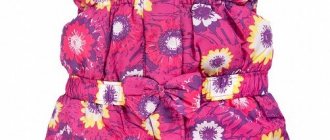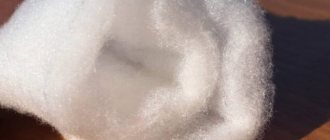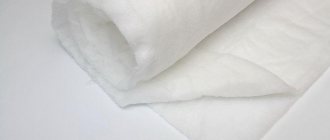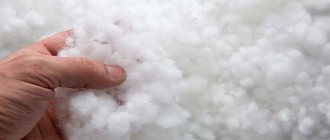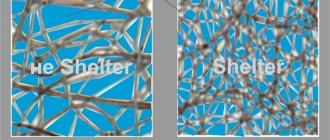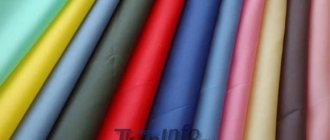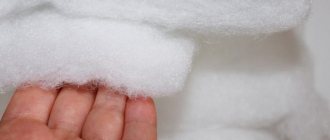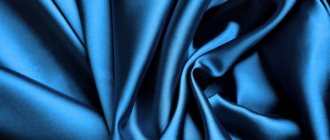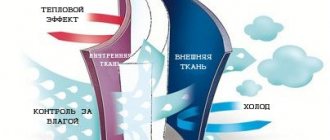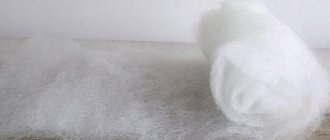In Russia, with its cold climate, warm but light outerwear has been and will be in demand among consumers. The urgent problem of creating high-quality, but inexpensive, insulating textile material to replace imported Russian production was successfully solved in September 2009.
Synthetic insulation termofin (termofinn) has no analogues on the domestic clothing market among textile offerings in the same price category. The new product advantageously combines Finnish technologies, German equipment and Russian production.
High-tech production
The company , owner of the Termofinn® brand, organized in the Odintsovo district of the Moscow region an ultra-modern automated production line with a length of 100 meters, which occupies 2 floors of a building and meets the requirements of Western standards.
The Termofinn manufacturing process, which is precise down to the minute, absolutely eliminates the influence of the human factor. Stages of unique production:
- First, the raw materials are supplied to the conveyor, where an accurate computer measurement of the amount of components takes place and they are mixed in a strictly fixed percentage.
- Vertical and, most importantly, horizontal (only from this Russian textile manufacturer) combing of fibers. The procedure gives the mass evenness and vertical, visible in cross-section, ordering of the fibers (approximately 80%). Due to this, Termofinn receives volume and low thermal conductivity.
- Melting in an oven at a certain temperature. The shell of the biocomponent fiber, when heated, twists and glues with conventional fibers, forming a three-dimensional three-dimensional structure. It is very important not to overheat the fibers, otherwise the output will be hard insulation and vice versa.
- Trimming the edges of the finished material using cutting shafts. Thanks to it, Termofinn rolls have a clear width, which is very convenient for cutting. The laser meter then adjusts the length of the web specified by the computer program down to the centimeter.
- Vacuum packaging of the goods is provided before direct shipment to the warehouse, which preserves the softness and structure of the insulation and protects it from caking.
Making thermofinn
High-tech production is fully automated. All work processes are controlled by computers. The raw materials are conventional and biocomponent fibers. The latter consist of a polyester core and a low-melting shell. Both types of fibers enter the conveyor in the required proportion. This mixture is carefully combed, as a result of which the fiber becomes absolutely even.
The next stage of production is melting in a special furnace. When heated, the shell of the biocomponent fiber twists and, attaching to conventional fibers, creates a three-dimensional structure. This is a very important process. The quality of the future insulation depends on the correct temperature and calculated melting time. If the parameters are chosen incorrectly, the material may turn out to be either too hard or unacceptably loose.
The finished blade passes through the cutting shafts. Here it acquires a smooth edge and becomes uniform in width. The parts are cut using a laser meter. The product is ready. Immediately before being sent to the customer, it will undergo vacuumization. This will maintain the required structure and softness of Thermofinn.
Description, technical specifications
Polyester fibers produced in South Korea are used as raw materials for Termofinn insulation.
Of these: 85% (the main part of the composition) are hollow, highly crimped and 15% are biocomponent whole fibers. Specifications:
- the material is available in densities of 100, 150 and 200 g/sq.m.
- The thickness of the blade varies: 1.2, 2.2 and 2.7 mm.
- depending on the thickness and number of layers, it is effective for protection at low temperatures from -15 to -55°C.
The actual weight, length and thickness of the roll have deviations not exceeding 2% from the declared product data. For comparison, according to GOST, up to 7% is allowed. The stability of the characteristics is beneficial when calculating the quantity of ordered material and its cutting.
Production: how thermofin insulation is produced
Highly twisted fibers make up 85% of the total weight, and bicomponent fibers, respectively, 15%. They form the basis and shell of future thermal insulation. Production is carried out on high-precision machines, which allows you to automate the process and almost completely eliminate the human factor from the process.
Due to the high degree of fire resistance, the core remains intact. Thanks to this processing, a material with a three-dimensional structure with a large number of air chambers is obtained.
Commercial properties of insulation
Environmental friendliness and safety. Termofinn does not accumulate odors and does not cause allergies. For its production, only primary raw materials are used - oil granules, and not processed recyclable materials mixed with garbage (glass shards, dirt, crumbs).
Termofinn textile insulation has the International Quality Certificate “Eco-Tex Standard 100” for the 1st product category. Things using termofinn are safe even for kids. Easy to cut and sew. The soft but elastic structure of the insulation does not crumble or climb. Practically does not flatten when quilting.
Excellently retains elasticity and shape after washing. Consisting of a low-melting shell and a polyester core, biocomponent fibers act as glue, so a highly crimped and thermally multiply bonded insulation structure is formed. Recovers well after compression. Shrinkage after 5 washes is 0.2%, which is 10 times less than GOST requirements.
Plasticity and softness due to the absence of a calendering “crust” sealing the upper and lower layers.
Dries quickly due to good moisture resistance.
Unpretentious clothing care:
- wash at 30°C with liquid detergents without bleach;
- gentle spinning and drying away from heating devices;
- Dry cleaning possible.
Clean, wash, dry
The insulating material is very easy to clean. It can be dry cleaned. Products made from thermofinn are washed at a temperature of 30°C without the use of bulk detergents and bleaches. It is recommended to squeeze them gently. You need to dry things away from heating devices.
Read about: Ecofiber
This magnificent insulating material will keep you warm even in the most severe frosts. And your sleep on soft pillows under the lightest blanket filled with thermofinn will be long and serene.
Where to buy Certificates
| Termoreal LLC | 109316, Moscow, Volgogradsky prospect, 47, office 409 | Tel/Fax (general) |
© 2021 textiletrend.ru
Practical use
Termofinn is widely used in the following areas:
- sewing various demi-season and winter types of clothing (sports, fashion, children's, uniforms) and hats;
- insulation of tourist sleeping bags;
- filling blankets and pillows.
Termofinn’s corporate identity is successfully emphasized by hanging labels on finished products, which Termoreal LLC supplies clothing manufacturers free of charge. The letter “O” in the logo, stylized in the image of a bullfinch, which does not mind severe frosts, and the combination of blue and red colors, symbolizing warmth and cold, emotionally convey the main qualities of Termofinn products.
Insulation for clothes. A small digest of the main brands of synthetic filler
As in the well-known expression “prepare your sleigh for winter in summer,” we suggest preparing for sewing a winter collection in advance and familiarizing yourself with the main range of synthetic insulation. In modern urban clothing, it's time to move away from bulky warming fillers. Shoes and outerwear should provide warmth while being elegant and light. So:
Insulation Sintepon
Good old synthetic winterizer is a long-proven inexpensive synthetic filler. It is used in the production of winter clothing, blankets and furniture.
This material has thermal insulation properties that allow items filled with it to be used at temperatures down to approximately -20 degrees. At the same time, it is lightweight. Sintepon makes warm and at the same time almost weightless soft blankets.
If moisture gets in, the material dries quickly, it is moisture resistant and does not absorb odors.
The elastic properties of this filler allow products to retain their shape well and not deform with frequent use and washing. At the same time, its volume makes things soft.
A good padding polyester is environmentally friendly. Bedding products made from this filler are safer even than products made from natural materials. Bacteria and bed insects do not develop in it. In addition, this material is durable and does not produce dust.
Holofan insulation
Holofan is a modern technological insulation, an improved padding polyester. Most often it is used in the production of winter clothing for children.
Hollophan fibers are hollow (this explains its name from the English word hollow) and its properties are close to natural fluff. Therefore, down jackets made from this filler are very warm and light in weight. This filler can withstand even deep sub-zero temperatures. At the same time, it is comfortable even in positive temperatures.
The structure of twisted fibers is springy, so the material easily restores its original shape and retains its volume even after long-term, repeated use. This material is much stronger than most other synthetic insulation for outerwear.
The advantage of holofan over down products is that they can be washed in a machine and are easy to care for. The washing mode in any type of machine is 40%. The material does not shrink after washing.
This insulation does not absorb odors and moisture; excess moisture is easily released outside. Hollophan is resistant to bacteria, environmentally friendly and hypoallergenic.
Insulation Thinsulate
One of the best insulation materials created today is the advanced Thinsulate fabric, created for use in extreme conditions.
Thinsulate is a polyester material whose fibers are treated with silicone and twisted in a spiral. It is incredibly thin - the diameter of the fiber is much smaller than the diameter of a human hair. Thinsulate is called artificial swan down, but its warmth indicators are much higher than that of this organic prototype.
The fiber was developed by order of NASA, since its scope of application was to be space and the Arctic. A little later, the material began to be used to equip skiers. Today, this insulation has become the leader in popularity in professional and sportswear, as it can withstand the most extreme frosts, does not absorb moisture and is resistant to deformation.
In addition to excellent thermal conductivity, Thinsulate has one more feature - it is absolutely safe. Its use is recommended for allergy sufferers and newborns. Its area of application is the production of bedding, shoes, outerwear and haberdashery.
Holofiber insulation
Hollowfiber is a technological material made from many hollow fibers, thermally bonded. This elastic polyester fiber is as close as possible in terms of safety to organic materials, while possessing all the valuable characteristics of synthetics: versatility, strength and wear resistance. The owner of the Holofiber trademark and the manufacturer of the material is Moscow.
Among modern insulation and fillers, holofiber occupies a special place - a material that is the pride of Russian developers. It has been certified according to hygienic and environmental standards, which gives the right to use it in the production of children's products. But the scope of holofiber is not limited to this. Its main purpose is to serve as insulation. In terms of thermal insulation quality, this fabric is superior to padding polyester, batting and felt, which explains its popularity and the widest range of applications. It has been used for sewing army uniforms for 10 years now. Today, it is impossible to imagine the production of seasonal clothing, soft toys, blankets, pillows and furniture without holofiber.
Flytex insulation
Excellent warming material made in Belarus from polyester fiber. Tested in accordance with Oeko-Tex Standard 100. The special multi-layer structure allows for excellent thermoregulation. This insulation has a high degree of resistance to abrasion, bending and generally allows you to fold it as you like without compromising its quality characteristics. Resistant to repeated washing. It is light and compact. It is convenient to cut. Flytex is perfect for sewing everyday adult and children's clothing, as well as for the production of a various range of sports and special clothing (there is a brand of product that does not support combustion).
Thermofinn insulation
High-quality insulation, manufactured using Finnish technology by a responsible Russian manufacturer. The manufacturer of the product under the Thermofinn brand assures us that the quality management system in production meets all the requirements of ISO standards. “Termofinn” demonstrates excellent consumer characteristics and takes a worthy place among the brands of insulation that everyone knows:
- Has high-quality thermal properties
- Highly resistant to moisture
- wear-resistant
- Quite light and compact
- After multiple washes, shrinkage is only 0.2%
Important technical data:
- The following values are stated for thickness: 12 mm; 22 mm; 27 mm.
- The insulation has a density: 100 g/m²; 150 g/m²; 200 g/m².
- Maintains comfortable temperature conditions down to -30°C.
This filler is used for sewing all kinds of demi-season and winter types of outerwear for various purposes (sports, tourism, casual, children's and special-purpose uniforms), as well as for insulating a variety of related products.
Let’s add a couple more interesting ideas for “warming up” in inclement weather, which are undeservedly forgotten or their appearance on the market does not cause a loud stir:
Shelter fabric
When creating winter looks, it is not enough to focus only on the stylishness of clothing items. You definitely need to put together a couple of outfits that will easily protect you from the cold. In addition to apres with lunar rovers, it would be nice to get a down jacket or anarak with high-quality insulation. Modern matter shelter can easily play such a role.
This is a material that has a number of pleasant characteristics:
- Its fibers are thinner than similar materials. They stick together like a spider's web and don't bunch up when worn.
- Shelter fabric is soft, breathable, quickly takes on the required shape, increasing the comfort of movement.
- In its “compact” form, this material does not lose its excellent heat-shielding properties.
And the ability to become electrified is absolutely not typical for shelter fabric. Thanks to this, it is widely recommended for sewing, for example, ammunition for people working with flammable liquids.
Material Felt
Felt is a type of felt, the raw materials for which are natural or artificial fibers. Natural material is made from down and wool, while synthetic material is made from acrylic or polyester.
Natural felt is considered an environmentally friendly and safe material, has antibacterial properties and has high thermal conductivity. Regardless of its origin, this material is light, wear-resistant, does not crumble when cutting and is malleable in processing.
Its structure and appearance depend on the source raw materials. The surface can be fleecy, imitate suede or velor, or be smooth. Felt is used to make clothes, shoes and designer accessories that look impressive and appropriate in modern looks. This plastic canvas is an expressive tool for creativity - its bright colors are used in all kinds of applications and crafts. Felt is one of the best materials for needlework. This bright, soft and warm material will allow you to realize any design idea.
When caring, avoid high temperatures and intense spinning. Delicate handling will allow felt items to last a long time.
Of course, this list does not completely reflect the range that is currently presented on the insulation market. Our goal was to give a general idea of this product category. To try to convey to the consumer that padding polyester, batting, down and fur are far from the only fillers in your items. Modern materials are more compact, lighter, wear-resistant, support impeccable thermoregulation, do not cause allergic reactions, you can crumple them as you like, they are resistant to moisture.
Dear customers, if you ask sellers for products based on these insulation materials, there will be an offer.
New fabric versions
The manufacturer has modernized the classic version of termofinn insulation and created 2 new versions of the product.
Termofinn Plus appeared on the market in 2013. It has a calendered surface with minimal fiber migration. The insulation features a more simplified cutting process.
In 2014, termofinn micro insulation with a calendered “crust” was introduced; it is certified according to GOST standards. The main feature is the presence of ultra-thin microfibers. Each microfiber, which is 50 times thinner than a hair and up to 10 microns in diameter, is surrounded by an air layer. Breathable material does not absorb moisture and remains dry. In addition, it has antistatic properties.
Composition: what is thermofin insulation made from?
It is made of highly twisted and bicomponent fibers. They are similar to swan feathers, but are a completely synthetic material. Insulating non-woven fabric is made from polyester and consists of a huge number of tiny polyester-based fibers. Small voids in the structure of the material ensure its lightness and breathability. The small size of the cavities prevents moisture from entering.
During production, the bundles are shaped into a slightly spiral shape, which gives them greater flexibility. This allows the insulation to retain its shape for a long time, preventing the fibers from sticking and tangling. The material acts as an insulator due to the formation of an air gap in the spirals.
Sintepon
Synthetic winterizer is an old-timer on the market of synthetic clothing insulation, the most common and most affordable material of this class. It is based on polyester fibers, fastened together in various ways. The widespread use of synthetic winterizer is explained by its versatility and excellent consumer qualities, primarily low hygroscopicity and easy maintenance. The temperature threshold for using padding polyester is –10 °C, and therefore it is most often used for demi-season clothing.
Outerwear with synthetic insulation from Belarosso
Holofiber
The non-woven holofiber filling is practically not inferior in thermal insulation to natural down. This improved type of padding polyester is characterized by durability, environmental friendliness, increased elasticity and low weight. The thermal conductivity of holofiber is almost half that of padding polyester, while this insulation with zero hygroscopicity reliably protects at temperatures down to –30 °C. Holofiber is quite lightweight, but at the same time voluminous and low-plasticity, which explains its use in the sports and tourism industries.
Outerwear with padding polyester Air Twin from Belarosso
Isosoft
Synthetic material isosoft is one of the most popular insulation materials in the textile industry. It is made from ultra-fine fibers that form a durable structure and is available in different densities, which allows it to be used in clothing for different seasons. Isosoft is lightweight, has good elasticity and softness, is easy to wash and dries quickly. A double-sided spunbond coating is additionally applied to the surface of the isosoft, which prevents displacement and deformation of the fibers during operation. In terms of its heat-saving parameters, one layer of isosoft replaces four layers of traditional padding polyester!
Outerwear with isosoft insulation from Belarosso
Recommendations for product care
Caring for the insulation is quite simple. Each item or product with a heat protection filter can be washed by machine or by hand. However, it is worth remembering a few rules for caring for such material:
- wash with gentle wash;
- Do not use bleach or powder;
- spin 400-600 rpm;
- drying away from heat sources, preferably in the air.
If such conditions cannot be met, and the item needs to be washed, it is better to wash it dry, which thermofins tolerate well.
Biofluff
Bio-down is a high-tech biomaterial for insulating outerwear. It is considered one of the first bio-based fillers to be used in the textile industry. This environmentally friendly material is constantly renewed in the natural environment, and its preparation uses a unique technology that reduces the consumption of fossil fuels. Lightweight and easy to care for, bio-down very quickly became a popular and practical insulation material both for the production of fashionable clothing for the cold season and for the manufacture of specialized winter equipment. Thanks to its soft three-dimensional structure, this material is light, resilient and elastic, and also has high thermal insulation qualities. And unlike natural fluff, it is hygienic and completely hypoallergenic!
Outerwear with bio-down insulation from Belarosso
Types of synthetic insulation
For a long time, any artificial insulation was called padding polyester. However, today, under this household name, it is no longer easy to combine all the variety of synthetic materials used for insulating outerwear. Most non-natural insulation materials are based on artificial polyester fibers - but in different materials they differ in density, thickness, texture, type of twist and additional surface treatment. At the same time, any changes, both in the design of the insulation layer in order to strengthen it, and in the shape and length of the fibers, allow manufacturers to patent more and more new brands that differ from each other in consumer parameters. Hollofiber, bio-down, Thinsulate, Isosoft are just a few examples of the most recognizable modern materials that you might encounter on the labels of women's warm jackets and coats.
Advantages of synthetic insulation
Nowadays, the bulk of clothing is made from synthetic fabrics, rather than from natural raw materials. Despite the fact that some women retain an unjustifiably biased attitude towards artificial materials, the fact remains: in terms of their heat-protective and performance characteristics, modern synthetic insulation materials are significantly superior to natural ones. They are more functional and guarantee comfort, beauty and safety in all weather conditions.
For example, with all the advantages of natural down, this material is capricious in production and care, wears out quickly, takes a very long time to dry and is a desirable habitat for various kinds of microorganisms. Wool is hypoallergenic, but can irritate the skin. It is subject to wear, shrinkage, is afraid of a humid environment and significantly weighs down clothing, which is why it is not used in sports equipment and clothing for active recreation, for which the weight and volume of products are of key importance. In addition, when wet, both down and wool almost completely lose their heat-protective properties. In conditions of high humidity, having very low hygroscopicity, air-filled synthetic insulation copes with thermal insulation much better.
Fashionable autumn coats, quilted with padding polyester
When choosing outerwear, every young lady is guided not only by the requirements of fashion, but also by purely practical considerations. A number of undeniable advantages are pushing the fair sex to increasingly prefer synthetic insulation:
- High heat retention
- Excellent breathability
- Low thermal conductivity of the fiber material
- High elasticity and mechanical strength
- Soft and elastic, no deformation
- Light weight and thickness
- Hygienic and hypoallergenic
- Wear resistance
- Easy to care for
- Fast drying
Air Twin
The Air Twin insulation system is an improved derivative of the classic padding polyester and holofiber. This is a unique technology, which is a 3D package of hollow volumetric and very light fibers. Special processing of fibers allows you to significantly increase the volume of the heat-protective layer of air and at the same time reduce the weight of clothing. In its softness and thermal properties, Air Twin is as close as possible to natural down insulation, and in ease of care and the absence of allergic reactions it surpasses them. The Air Twin structure promotes rapid removal of moisture from the human body, greatly increasing comfort during use. This new generation insulation provides the product with an excellent appearance and is actively used in Twin Tip demi-season outerwear.
Outerwear with padding polyester Air Twin for cold winter weather
